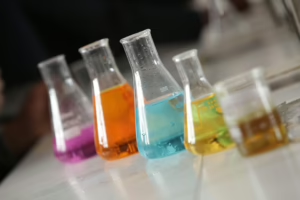From Atoms to Reactions: A Journey Through Chemistry
Chemistry is often described as the central science, bridging physics with other natural sciences like biology and environmental science. Understanding chemistry is crucial for mastering various disciplines, as it gives insight into the fundamentals of matter and the interactions that govern the universe. In this exploration, we journey through the foundational elements of chemistry, from the smallest particles—atoms—to the complex reactions that govern life and industry.
Understanding Atoms: The Building Blocks of Matter
Atoms are the basic units of matter. Compromising protons, neutrons, and electrons, they form the fundamental building blocks of all substances.
Structure of the Atom
-
Protons and Neutrons: Found in the nucleus, the protons carry a positive charge, while neutrons are neutral. The number of protons, known as the atomic number, defines the element.
-
Electrons: These negatively charged particles orbit the nucleus. Their arrangement and number determine the atom’s chemical properties and its reactivity.
- Isotopes: Variations of elements that have the same number of protons but different numbers of neutrons. For example, Carbon-12 and Carbon-14 are isotopes of carbon.
The understanding of atomic structure was revolutionized by various scientists, notably J.J. Thomson, who proposed the ‘plum pudding model’, and Ernest Rutherford, who discovered the nuclear structure of the atom through alpha particle scattering experiments, leading to the Rutherford model of the atom.
The Periodic Table: Organizing the Elements
The periodic table is an essential tool in chemistry. Developed by Dmitri Mendeleev, the table organizes elements based on their atomic number and electronic configuration.
Trends in the Periodic Table
-
Groups and Periods: Elements are arranged in vertical columns (groups) and horizontal rows (periods) based on similar chemical behavior.
-
Electronegativity and Atomic Radius: These properties follow specific trends—generally, electronegativity increases across a period and decreases down a group.
- Metals, Nonmetals, and Metalloids: The periodic table is also divided into these categories, influencing chemical behavior and bonding.
The periodic table’s organization reflects the periodicity of elemental properties and provides a systematic approach to studying and predicting chemical reactions.
Chemical Bonds: The Forces that Hold Atoms Together
When atoms come together, they form chemical bonds, fundamentally influencing how substances interact.
-
Ionic Bonds: Formed through the transfer of electrons from one atom to another, resulting in charged ions. For example, sodium chloride (NaCl) is created when sodium donates an electron to chlorine.
-
Covalent Bonds: Formed when atoms share electrons, typically between nonmetals. Water (H₂O) and carbon dioxide (CO₂) are prime examples.
- Metallic Bonds: In metals, electrons are pooled in a ‘sea of electrons’ that allows for conductivity and malleability.
The nature of these bonds determines the physical and chemical properties of substances, influencing factors such as boiling and melting points.
Chemical Reactions: Transformations of Matter
Chemical reactions involve the transformation of reactants into products, governed by the laws of thermodynamics and kinetics.
Types of Chemical Reactions
-
Synthesis Reactions: Two or more substances combine to form a single product. For example, hydrogen and oxygen combine to form water.
-
Decomposition Reactions: A compound breaks down into simpler substances. An example is the electrolysis of water.
-
Single and Double Displacement Reactions: In single displacement, one element displaces another from a compound. In double displacement, components of two compounds exchange places.
- Combustion Reactions: Hydrocarbons react with oxygen to produce carbon dioxide and water, releasing energy.
The Role of Energy in Chemical Reactions
Energy plays a critical role in chemical reactions, influencing reaction rates and equilibrium.
-
Endothermic and Exothermic Reactions: An endothermic reaction absorbs heat, while an exothermic reaction releases heat, illustrating the energy transformation during chemical changes.
-
Activation Energy: The minimum energy needed for a reaction to occur. Catalysts can lower this barrier, increasing reaction rates without being consumed.
- Le Chatelier’s Principle: States that if a dynamic equilibrium is disturbed, the system shifts to counteract the change, influencing the concentrations of reactants and products.
Organic Chemistry: The Chemistry of Life
Organic chemistry, the study of carbon-containing compounds, is essential for understanding biological processes.
-
Hydrocarbons: The simplest organic compounds, consisting of hydrogen and carbon. Alkanes, alkenes, and alkynes exhibit varied properties based on their bonding.
-
Functional Groups: Groups of atoms that confer specific properties and reactivity, such as hydroxyl (-OH) in alcohols or carboxyl (-COOH) in acids.
- Biomolecules: Carbohydrates, proteins, lipids, and nucleic acids are vital for biological functions. Their structure and reactivity are rooted in organic chemistry.
Biochemistry: The Intersection of Biology and Chemistry
Biochemistry explores the chemical processes within and related to living organisms.
-
Enzymes: Biocatalysts that speed up biochemical reactions, crucial for metabolism. Their structure and function are tightly regulated, ensuring efficiency and specificity.
-
Metabolic Pathways: Series of chemical reactions occurring in cells. Pathways like glycolysis and the Krebs cycle illustrate the interconnectedness of biochemical reactions.
- Genetic Information: The chemical structure of DNA and RNA, highlighting how genetic information is stored, replicated, and expressed.
Environmental Chemistry: Chemistry of the Earth and Atmosphere
Environmental chemistry examines chemical processes occurring in the environment, focusing on natural systems and human impact.
-
Pollutants: Understanding the chemical nature and behavior of pollutants helps in developing strategies for their mitigation.
-
Green Chemistry: An approach to chemistry that aims to design chemical products and processes that minimize waste and reduce hazardous substances.
- Climate Change: The role of greenhouse gases and chemical reactions in climate dynamics underscores the importance of chemistry in addressing global challenges.
Conclusion: The Future of Chemistry
As we stand at the crossroads of innovation, the future of chemistry holds promise across various fields—from materials science and nanotechnology to pharmacology and renewable energy. Advances in understanding atomic and molecular interactions will drive transformative changes that benefit society and the environment.
Chemistry’s profound influence on daily life—from the air we breathe to the food we consume—highlights its importance in the modern world. Personal and societal growth relies on understanding and applying the principles of chemistry to solve pressing global challenges and improve quality of life.
References
- Atkins, P. W., & Friedman, R. (2011). Molecular Quantum Mechanics. Oxford University Press.
- Timmons, R. C., & Buxbaum, J. (2015). Chemistry: A Molecular Approach. Pearson.
- Berg, J. M., Tymoczko, J. L., & Stryer, L. (2015). Biochemistry. W.H. Freeman and Company.
- McGowan, C. W. (2003). Environmental Chemistry. Springer.
- Greene, T. W., & Wuts, P. G. M. (2012). Protective Groups in Organic Synthesis. John Wiley & Sons.
This article encapsulates chemistry’s essence—from atoms to complex reactions—highlighting its significance and interconnections throughout science and daily life. Whether one explores the nuances of organic compounds or delves into the fundamental principles of atomic structure, the journey through chemistry is both informative and essential for understanding our world.
























Add Comment